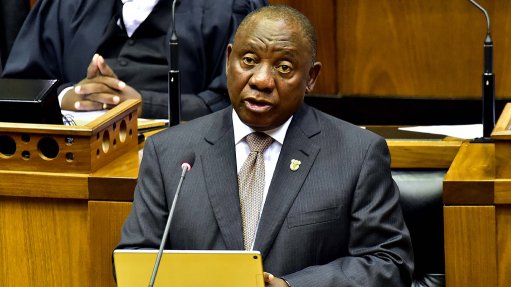
President Cyril Ramaphosa
President Cyril Ramaphosa last week announced far-reaching and practical interventions to address South Africa’s growth- and confidence-sapping electricity crisis, including several steps to “significantly increase generation capacity outside of Eskom”.
He also warned, however, that “debilitating” load-shedding would remain a “possibility for the immediate future”, while State-owned power utility Eskom undertook the “fundamental maintenance necessary to improve the reliability of supply”.
In what was his fourth State of the Nation Address (SoNA), which was delayed for more than an hour-and-a-half as a result of ongoing disruptions by the opposition Economic Freedom Fighters, Ramaphosa said measures would be taken, over the coming months, to “fundamentally change the trajectory of energy generation in our country”.
To rapidly increase non-Eskom generation capacity, he announced actions including the following:
- the imminent issuance of a Section 34 Ministerial Determination to give effect to the Integrated Resource Plan 2019, enabling the development of additional grid capacity from renewable energy, natural gas, hydropower, battery storage and coal;.
- the initiation of the procurement of emergency power from projects that can deliver electricity into the grid within three to 12 months;
- the continued registration by the National Energy Regulator of South Africa (Nersa) of small-scale distributed generation for own use of under 1 MW – such facilities would require no licence;
- Nersa would ensure that all applications by commercial and industrial users to produce electricity for own use above 1 MW were processed within the prescribed 120 days, with no limit to installed capacity above 1 MW;
- the launching of Bid Window 5 of the Renewable Energy Independent Power Producer Procurement Programme (REIPPPP) and the opening of discussions with successful bidders from REIPPPP Bid Window 4 to accelerate the completion of their projects;
- the negotiation of supplementary power purchase agreements to acquire additional capacity from existing wind and solar plants; and
- the development of measures to enable municipalities, in good financial standing, to procure their own power from independent power producers.
The initiatives were broadly aligned with the call by Business Unity South Africa that the President use the SoNA to announce the regulations needed to enable “private-sector energy generation at scale”.
However, some concern was raised following the speech regarding the fact that no explicit statement was made on the wheeling of power generated by large plants developed to support mines and factories.
The emergency procurement programme, meanwhile, was already being advanced under the aegis of the Department of Mineral Resources and Energy (DMRE), which issued a request for information (RFI) in December for 3 000 MW of emergency electricity solutions that could be “grid-connected in the shortest time at the least possible cost”.
It is understood that the DMRE received hundreds of responses to the RFI by the closing date of January 31, but the department indicated earlier this month that it was still evaluating the information and told Engineering News & Mining Weekly that it would comment only once all inputs had been processed.
For Eskom itself, Ramaphosa announced that the process of “divisionalising” the utility’s three operating activities of generation, transmission and distribution would be implemented.
He said this process would be in line with the Eskom Roadmap announced by Public Enterprises Minister Pravin Gordhan in 2019. However, he adopted the ‘divisionalisation’ nomenclature favoured by Eskom CEO André de Ruyter, rather than the “unbundling” term used in the Department of Public Enterprises document.
Each division, Ramaphosa said, would have its own board and management structures.
He also praised recent efforts by the social partners represented at the National Economic Development and Labour Council to craft a “social compact on electricity” and address Eskom’s financial crisis in a “financially sustainable manner”.
“Through this compact, the social partners seek an efficient, productive and fit-for-purpose Eskom that generates electricity at affordable prices for communities and industries. This requires both a drastic reduction in costs – including a review of irregular contracts – and measures to mobilise resources that will reduce Eskom’s debt and inject fresh capital where needed.”
The social partners, he added, would also seek to mobilise funding to address Eskom’s financial crisis “in a manner that does not put workers’ pensions at risk and that does not compromise the integrity of the financial system”.
The Congress of South African Trade Unions made a proposal earlier this month to reduce Eskom’s debt from R450-billion to R200-billion through a special-purpose vehicle involving workers’ pensions.
Initially, business and government welcomed the proposal, but greater circumspection has since emerged, as other unions objected to the proposal and questioned its legality.
Ahead of the SoNA, the Public Investment Corporation (PIC) raised its concern about suggestions that the PIC, on behalf of its clients, would provide funding to bail Eskom out.
The PIC manages in excess of R2-trillion on behalf of clients that include the Government Employees Pension Fund, the Unemployment Insurance Fund, the Compensation Commissioners’ Fund and several others.
The PIC said it was well aware of the risk that Eskom posed to the South African economy and to the funds invested on behalf of its clients and said it was ready and keen to engage with various stakeholders to find a suitable and sustainable solution for the systemic risk posed by Eskom.